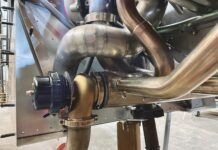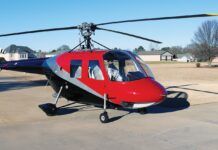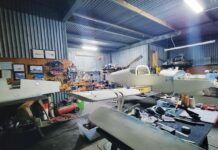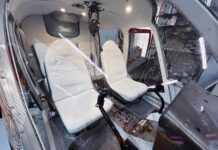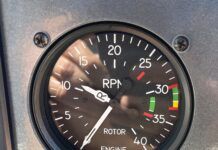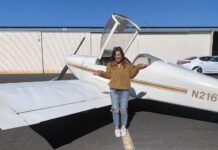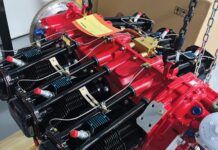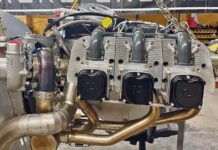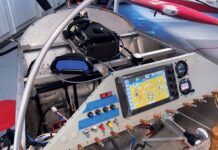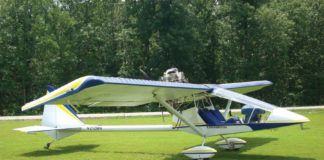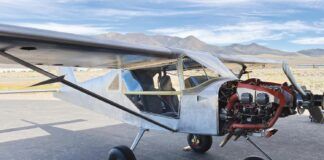KITPLANES Magazine, November 1997
Building a RotorWay 162F
Part 8 of 8: We’re finished and flying the new RotorWay helicopter.
by Jeff Dunham
It’s hard to believe, but by the time this issue is released, nine months will have passed since we began this series, and amazing or not, after a lot of effort, a huge amount of fun, and a bunch of time spent learning about helicopters inside and out, we’ll complete construction on our 162F and get her flying!
Before we lift off, though, we have to head out to RotorWay in Arizona for some flight and maintenance training, and we’ll get some good tips on building the blades and final rigging of the ship. We’ll then come back to the shop to finish the blades, and finally we’ll head back out to the hangar for our own final rigging and tweaking of the rotor system. Then we’ll pick her up in a hover and do some flying.
As I’ve stated all along in this series, RotorWay doesn’t just sell you a pile of parts with some instructions and a wish of good luck. On the contrary, when you pay RotorWay that big chunk of change, you’re buying into a full circle program that will enable you to not only build a solid and well proven helicopter, but you’ll be given the opportunity to attend RotorWay’s flight school and earn your rotorwing private pilot’s license, with the final check ride given by RotorWay’s own in-house FAA examiner.Back to Work.
Last issue we were left standing on the ramp with a purring, bladeless ship, watching and listening to all the systems run, making sure all was within specs and functioning properly.
My first start-up was completely uneventful with nothing exciting to reportÉwhich is a good thing! However, not long after I finished that last article, I discovered a couple of fuel drips coming from one of the fittings on the fuel cut-off valve. Rather than futz with it, trying to replace the fitting (kind of difficult since the fitting is permanently glued in place on the engine), I found an amazing invention called a Seco 7 seal, which solved my problems. The Seco 7 is a soft, malleable crush washer designed for MS, AN and JIC standard 37° flared fitting assemblies. It’s designed (now quoting from the promo material) “to take up for the minute imperfections that will occur to the fitting and tube’s mating surfaces during manufacture and installation processing.” In other words, if there’s a problem with either of the mating surfaces of the fitting or the tube, this little doodad will even out most gaps or incongruences and stop the leak. It comes in aluminum, copper or nickel in sizes of 1/8 inch through 3 inches.
It’s basically a cone-shape piece of metal that fits over the male end of the hose fitting. When mated with the opposite end, it flattens itself between the two surfaces, filling whatever gap is causing the leak. Pretty cool, and they fixed both my ship’s drips! If you need engineering data, customer samples, or price and availability information, call Seco at 714/546-3478. Rather then replace a fitting or a hose, you can just use one of these little things.
It’s all part of the game when building your own aircraft that you’ll occasionally run into frustrating little problems that take a lot of time and demand immediate attention. For example, these two fuel leaks used a lot of time that I would have rather spent getting the machine flying. Nonetheless, after the repair and more scrutinizing of the rest of the fuel system, it was time to build the blades. …
It’s Off to Boot Camp
It’s at this point in a builder’s construction that RotorWay suggests its builders take a trip to Phoenix and attend flight school. So right now we’ll detour and head to boot camp.
It was 10 years ago when I experienced RotorWay’s school and flight training for the first time, and I continue to return every two years for my biannual flight review and a little brush-up flight instruction.
There are three phases of training, each one a week-long adventure that you must schedule separately according to your progression in the building and flying process. Phases I and II are a week each and meet for five days from 7:30 a.m. to 3:30 p.m.
Phase I recently increased the number of flight hours given to a student to 10, (2 hours a day), with the other 6 hours spent each day in class learning about FAA regulations, RotorWay’s rotor systems and engines, basic maintenance, and general troubleshooting. In the flight training portion, this first session is hover week.
Depending on the skill and knowledge of the student, most guys go home at the end of the five days with a hover only endorsement in their logbooks. According to FAA regs, this must be hovering within ground effect, which is not more than 4 feet of skid height, and you can fly up to but not beyond translational lift speed, which is approximately 15 mph. The cost for this week at RotorWay: $1800. Usually 90-95% of the students pass their first time in.
I asked Stretch Wolter, the chief instructor, about the biggest obstacle when learning to fly. “The biggest problem for these guys is usually knowing what to do and when to do it, and then to relax and just do it.”
From my first few hours, I remember exactly what he was talking about. When hovering a helicopter, there are many dynamics taking place all at once with every limb and each sense being used to fly.
If I was like most people, when I got over being nervous, it finally just hit me and the ship was sitting in mid-air in one place with me barely touching the cyclic stick. Men tend to overcompensate, and women make the more correct, small movements and thus don’t overcontrol. For new students, overcontrol is a major obstacle between motionless hovering versus being literally all over the place. Anyway, during Phase I training, each student learns at his own pace. If someone already has some rotorwing experience or is simply some kind of flying whiz, he may move quickly into Phase II. Normally, though, after completion of Phase I and after an endorsement is entered in the student’s log book, RotorWay wants you to go home, finish the final construction on your machine as you’ve been taught, then put many hours on it perfecting your hovering technique, while at the same time tweaking the rotor system.
The average student will want to put 20-30 hours of hovering on his ship: lots of practice while flying safely at only a couple of feet off the ground. This is the wisest way to go considering that not only are most guys student pilots, but they’re test pilots as well, flying a brand new, untested helicopter! If anything goes wrong mechanically, it usually happens within the first few hours, and you wouldn’t want to be at 1000 feet. Also, at 2 or 3 feet, if a crash or roll over does occur, you have a pretty good chance of banging up only the ship.
Phase II
After all the required hovering maneuvers stated in the RotorWay syllabus can be accomplished by the student, it’s time to head back to Arizona for Phase II. This week’s flight training involves forward flight, translation and emergency procedures, and classroom time is spent discussing the same topics. Most important, in the classroom and at the stick, you’ll be learning about the envelope of RotorWay helicopters. Students are given 7.5 hours of flight instruction during this week, and the cost is $1500.
RotorWay likes to point out that their flight school is more a familiarizing with type kind of school rather than a traditional flight school. This means that a student is really being taught about RotorWay ships in particular and how to fly these particular helicopters. You won’t learn anywhere better about flying a RotorWay helicopter than right there at RotorWay.
After completing Phase II, the average student’s endorsement will allow flight in his own ship of all maneuvers within the flight envelope of the 162F that are outlined in the flight manual. Also, the average student is given a cross-country endorsement, but this can’t be used until the required test hours (often 25 hours) have been flown off the newly licensed ship.
Receiving your airworthiness certificate for the 162F is an entirely different subject, and we’ll talk about that a little later. But to sum up Phase II, if you pass like most folks do, you can fly your ship just about anywhere you normally would if you had your license, assuming of course that you’ve finished an approved ground school course that usually consists of 24 hours in a classroom, or from an approved home study course. A buddy and I used the King Video course and passed the written with no problem.
Home Alone Again
After Phase II it’s back to your own bean patch and more practice.
Though all this time spent at RotorWay is learning time, it really doesn’t get much more fun! You leave everything else behind in your life, and for five straight days, all you do is mess with helicopters. Also, though no one really needs to be competitive during flight training, how could you help but not be? Are you as good as or maybe better than the other two dorks in class? When you’ve never done it before, learning to hover is a pretty demanding skill, and can really test the mettle of a guy. And here’s another thing: You have spent a lot of time and money building something that you’re not really sure you can actually fly. What if you can’t? What if you just don’t have what it takes to keep that machine in one place in a hover?
Or what if you’re too chicken to drop the collective, ease the throttle into an idle, feel your stomach in your throat, and do an autorotation? All this went through my head when I went out to RotorWay, but nonetheless, I passed all three phases of training and earned my license. One guy in my class the first week had to return for another Phase I week, but apparently that’s pretty rare.
Phase III
For most people, Phase III week is short: usually only two days. The first day is spent as brush-up time, making sure the student still has good flying technique and really is ready for his license. The next day is the final check ride with Stretch, RotorWay’s in-house FAA examiner. Once a student meets the practical test standards given by a designee or inspector, he gets his license. Cost for Phase III: $500. Ain’t nothin’ cooler than this two days.
Despite the hell Stretch might put you through to pass your checkride, he never requires full-on autorotations; he simply requires you to enter the auto, stay in the steady state mode, then flare and bring her into a controlled hover at about 3 feet. Most accidents in helicopters occur when practicing full-on autos, and 3 feet is a height that no matter what you did if you got it down that far in a controlled attitude, you’d probably be just fine. Do you know what happens to a RotorWay ship if you chop the throttle in a 2-foot hover and do absolutely nothing? Usually nothing.
A Bit of Building
Anyway, let’s get back to construction. After being shown the proper techniques of rigging a rotor system in Phase I training, it’s back to the shop to finish the blades and put your newly acquired knowledge to use.
Here’s one more area where I’ll gripe that current builders have it a lot easier than we earlier builders did. Obviously the most important parts on a helicopter are the rotor blades, and there’s no room to screw these things up.
The 162F uses asymmetrical rotor blades that are prebalanced and matched in pairs at the factory. It used to be that you’d get just about finished with your ship with nothing left to do but the blades, and you were convinced you’d be flying in no time. Wrong! Many hours were needed to get the blades ready, considering all the parts that had to be cut out, prepped, lined up, glued, Bondoed, sanded, finished again, paintedÉ.Ugh. Now RotorWay has taken a lot of the time-consuming, precision gooey work out of blade construction, making some welcome updates and building time cuts!
Rotor Work
At the inboard portion of each blade, RotorWay has now already glued the four fiberglass doublers, with two on the top and two on the bottom. Wood blocks have been glued to these doublers. The factory now even Bondos the seam that goes along the length of the blade and paints the surface with primer. All the builder has to do in this area of the blade is sand the wood blocks to an absolute precise thickness, which allows a precision fit for the aluminum aligner blocks and blade straps when everything is bolted to the blade. RW only leaves about 0.010 inch of extra material on the blocks, so the sanding is quick and easy.
Next you have to cut the corner off the inboard corner of both blades, fabricate root and tip end blocks to be glued into place, and also cut out, locate, and mount the two 5-ounce tip weights. Once you’ve sanded and prepped the blade, a good coat of two-part epoxy paint is recommended for durability. You’re then ready to prep the blade straps and get ready to bolt them into place.
The straps come premounted on the blades, but that’s simply to keep the raw wood from expanding too much during shipment and storage. You have to remove the steel straps, clean them, deburr them, file the edges and paint them.
All holes for the blade straps have been predrilled in the straps as well as in the blades by RotorWay, so most of the alignment work has been done for you. However, precise alignment of these straps is critical for a smooth running system, so follow the manual closely and take your time! There’s nothing worse than a ship that won’t stop shaking no matter how you tweak it.
Next the pitch horns must be cut out, deburred and finish-filed. I have to admit, I took the pitch horns to a machine shop and had them cut out. I got lazy! They come prescribed, but geeze, is that aluminum thick! At the time I didn’t have a really nice band saw, and a guy did it for me for $10. It was worth it.
Now comes the bolt-together process of assembling all the blade parts to the blade and onto the rotor hub. These include the aforementioned blade straps, the pitch horns, the pitch horn clevises, the aligner blocks and bearings, and finally the thrust blocks that house the almighty elastomeric bearings.
I need to emphasize again how important it is to take your time at this point of construction. The steps taken to mount the straps and all the hardware to the blades are extremely critical when it comes to achieving a smooth running rotor system. Measure, remeasure, and check everything a third time. Use good tools and high precision dial calipers, dial indicator, bubble levels, and any other measuring devices you put your hands on. You’ll thank yourself once you get the thing hovering.
Hanging It
At some point along the way you’re going to need to do the hang test. Hmmm. What the heck is this? After the entire ship is finished less the main blades, and after you’ve installed all your radios, lights, interior liner and everything, you must hang the ship from the main shaft and check to make sure you installed the main shaft at exact angles.
As the helicopter actually hangs from the spinning blades in a hover, doing a static hang test will show you approximately what the ship’s attitude will be in the hover. If the required angles of the main shaft were held during construction, then in the static hang test, all should be fine.
The angle checks on the shaft have to be made fore and aft as well as laterally. Also, since sometimes there will be one person riding, and at other times two, both situations have to be simulated. So, I needed to find an average-weight “passenger” to help. You’ll also want to either find someone your exact weight while you take the measurements on the shaft yourself, or you’ll have to find a buddy you trust with a bubble level while you sit in the pilot’s seat.
I’ve included pictures of Mike Sherick doing his hang test. He had a much more spectacular set-up than I’ve ever seen! I just hung mine from the top of the hangar. (Yes, the hangar hanger was well supported.)
When we hung my ship and made all the checks, everything was perfect. With me at 173 pounds, a passenger at 165 pounds, and all the panels in place, there was 0° tilt all the way around the shaft. With only me in the ship and the ballast weight on the front right skid, we were also right in the middle of tolerance.
In the literature, RotorWay emphasizes that the static check is required and important, but the real test is when she is sitting in a hover! Where your cyclic stick rests in a hover is the actual test for weight and balance and correct shaft angles. The hang test is just to make sure you’re not way off. The closer to center your stick is in a hover, the less the rotor system has to work, and thus the smoother the rotor system and the less you’ll wear out parts.
Also, our ships can be rigged to hover or fly. For example, when my Exec 90 flies as it was built, it hovers beautifully. But for optimum cruising in forward flight, I add 10 pounds in the nose. That causes the cyclic stick to be pulled back a little farther in a hover, thus taking the rotor system out of a perfect zero situation. But at about 90 mph in forward flight, the cyclic stick isn’t too far off center, and thus it runs very smoothly at high speeds. I can outrun most other Execs.
Mount the Blades!
After the hang test, it’s time to mount the main rotor blades. Before mounting the blades to the ship, though, the strap assemblies must be bolted to the blades. Some sort of stands must then be constructed to hold the blades in place and simulate their coning angle. This will enable the blades to slide on the hub easily and not droop before the main bolt is final installed and torqued to specs. If the blades were to droop before the main bolt was tightened, unseen and permanent damage could occur to the hub, the pitch pins, and/or the blades themselves.
Some guys find it tough to get the blades on the hub itself, but the trick is to set the blades stands pretty high, making sure that when you slide them onto the pitch pins, the blades match the angle of the pins exactly. I kept the blades supported that high, sighted down from the top of the hub, and made sure that with the lead/lag sweep, the holes in the blade straps as well as in the thrust blocks lined up exactly. When you get everything lined up correctly, the main bolt will slide right down the holes with nothing more then slight hand pressure. Advice at this point is don’t hammer the bolt. If it won’t go in easily, that means something isn’t lined up correctly yet. Once the bolt was in place, I torqued the main bolts to required specs before removing the blade stands.
Static balancing of the blades is done with them on the ship. The 5 ounces of tip weight is added to the blades to aid in autorotations. When balancing, weight is subtracted from the heavy blade’s weight until everything evens out. I used a grinder. The final check for proper balance is putting a dime on the end of one of the blades, which should then make the blades and hub teeter slightly, like maybe half an inch. A dime? Wow! Make sure everything is level, and turn off the air conditioner! (Follow procedures in the manual for loosening the hub plate so it will teeter freely.)
Next the static lead/lag and pitch adjustments are made. Lead/lag is the sweep of the blade in relation to the hub. If the blade is leading too far, it’s ahead of the hub, and if it’s lagging, it’s behind the hub. Proper lead/lag occurs when, with nothing attached to the blade, it has zero degree pitch when allowed to feather freely: no lead or lag.
On our ship, you adjust the aligner block until you think lead/lag is approximately correct. You then shake the main shaft slightly, which will cause the blade to find its neutral point of feathering. Lead/lag is then adjusted until zero pitch is accomplished.
Proper pitch angles in relation to control inputs are accomplished with the bubble protractor as well.
Lead/lag affects balance and vice versa, so you will have to go back and forth a bit. This is a place to take your time! Do it right statically, and you’ll have much more fun and a much easier time when it’s time for the dynamic run-ups.
Next, we fabricate and final install the wood end plugs to the tips of the blades. Even though you’ll be using the same material on both ends of the blades, it’s smart to recheck balance after they’re installed. Even slightly more glue on one blade can affect balance. For example, on dynamic runup, one small wood screw can fix a slight shake. Even a 3/16-inch washer can make the difference in a noticeable vibration or none.
Final steps in construction are to locate the pitch horns, drill their holes, bolt them into place, and then assemble and attach the control rods between the rotating swashplate and the pitch horns. Everything needs to be lined up exactly!
Rigging is Section 25 of the manual, and it’s a great way to go through your ship and recheck everything. If you’re like most builders, the stuff you assembled months ago may have been forgotten. It’s good to go back and check to make sure you’ve rigged the correct amount of throw in the controls, and that all the angles match what is called out in the manuals. Check all belt tensions, hose clamps, everything.
Hopefully you time your Phase I training so that you finish your ship not more than a couple of months after attending class, so you’ll still have some sort of memory of how to fly! Now you tie your ship to the ground and run her up with blades attached for the first time! And yes, this is pretty dang exciting. The first time I did this on my first ship (1986, Waco, Texas), about seven of my friends were there to watch. Of course they were all hiding behind their cars at a great distance, just waiting for a disaster.
All will go fine if you don’t rush things. Even after only a few minutes of running, you’ll want to stop the ship and check all your belts for correct tension, especially your main and tail rotor belts.
Actually Fly It?
As for hovering, if you’re a new pilot, be careful! Loosen the tiedown ropes slightly only when you’re sure you can control your ship, keeping it in one spot. When you actually leave the ground, keep about 18 inches of altitude (that’s what RotorWay recommends), and don’t let her fly sideways.
Whatever you do, make sure where you’re practicing is on a flat, level surface with nothing to catch your skids! You should be able to slide easily in any direction. At this point in learning, it’s very easy to catch a skid on anything small; even a big weed or small bump in the ground is enough to roll the ship over. It happens to pilots regularly, in every kind of helicopter.
If you feel you need some more instructor stick time before soloing, head back to RotorWay. Also, don’t let a pilot who has never flown a RotorWay ship fly yours, unless he’s been qualified in another RotorWay ship. Unfortunate accidents, both minor and fatal, have occurred when veteran pilots with thousands of hours jump in a RW ship, convinced they can fly anything.
One good reason not to let them is that the blades on our ship turn clockwise, which is the opposite from most other helicopters. A guy who has flown a Robinson won’t be used to opposite torque. Think about those implications and you’ll understand.
As for the required FAA inspection, contact your local FAA office and find out who does the inspections. Talk to him and be nice. Because of the lack of manpower in the last decade, most inspectors won’t want to look at your ship until it’s ready to fly. Every inspector is different, though. On Mike Sherick’s inspection, he had three men who went through the ship from stem to stern with a fine toothed comb and it took almost 4 hours. He of course passed just fine.
My inspection was with one guy and it took about 10 minutes. What was the difference? Every inspector is different. Make sure you document your construction with both a log and pictures. They love to see that stuff. They’ll want to know that you actually did the work.
I completed the 162F within the time frame we guessed at nine months ago, and now all I need to do is hover more hours needed to be safe before taking it to altitude. RotorWay suggests 12-20 hours of hover time before you go up. After any kinks are fixed, I’ll paint the ship and detail her out.
Philosophy Time
Some of the most fun I’ve ever had has been with my RotorWay Exec 90, and I’m sure the same will happen with my 162F. On one of the first dates I had with my wife, I took her flying in the Exec 90 around San Diego, over a secluded beach and the ocean, then to a mountain top 30 miles away where I kissed her at sunset. We now have three little girls, and the five year-old has flown with me a few times and loves it.
Thanks to Mike Sherick for his input and a good number of pictures throughout this series, and of course thanks to KITPLANES and Dave Martin for publishing it all. And thanks to all the folks at RotorWay for all the fun, and especially thanks to my gorgeous wife, Paige, who puts up with all my antics.
To see more of author/builder/ pilot/entertainer Jeff Dunham, check his web site http://www.onastick.com/ Jeff and his ventriloquist dummy companions (Peanut, Walter and Jose Jalapeno “on a steeeck!”) are well known in Las Vegas and on network television.
FOR MORE INFORMATION on the RotorWay International kit helicopter, contact the company at 4140 W. Mercury Way, Chandler, AZ 85226; call 602/961-1001; fax 602/961-1514; www.rotorway.com.


